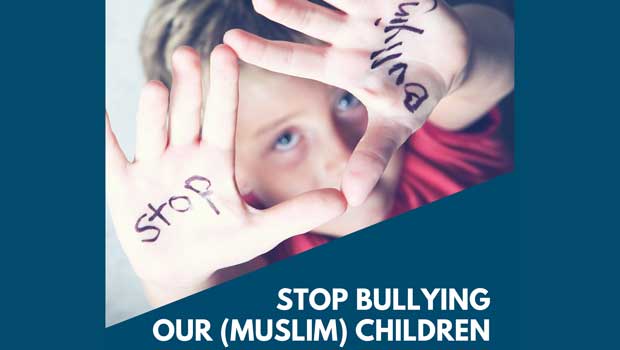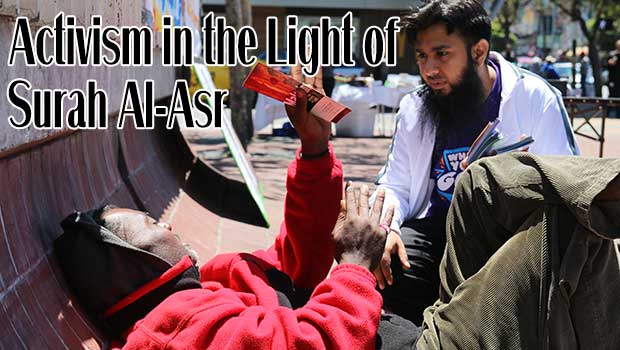Stop Bullying Our (Muslim) Children: ICNA’s CSJ National Campaign
–
Bullying is physical, emotional, or socialharassment, intimidation, or aggression toward a perceived weaker individual or group with the deliberate intent to cause them harm. It is a serious problem that plagues America. Many children are bullied at some point while growing up. According to the National Center for Educational Statistics, more than one out of every five students (20.8 percent), ages 12 through 18,reported being bullied during the 2014-2015 school year. Bullying can occur in a variety of places such as a classroom, playground, cafeteria, or bathroom. Many people think of a bully as a large, male figure that physically bullies his smaller counterparts. However, anyone can bully, regardless of their size or gender. A person can bully by excluding a person from an activity, destroying someone’s property, name calling or insulting, spreading rumors,or physically intimidating or harming them. Cyberbullying involves posting something insulting or embarrassing on social media about another person.
It is important for school staff, parents, and students to stay attentive to any signs that a child/you this being bullied, as a victim does not always confide their experiences to anyone, out of fear or embarrassment. According to stopbullying.gov, some of the signs of bullying include unexplainable injuries, lost or destroyed belongings, feeling sick or faking illness, or changes in eating habits.
Muslim community support children who are bullied and not assume that the problem will go away as the children grow older. Problems must be addressed immediately, otherwise they may persist and grow into more complex issues that will negatively affect them later in life
Muslims students have experienced a lot of bullying since 9/11 and again are facing an upsurge with the increasingly xenophobic and anti-Muslim environment today. Bullying based on one’s religion can make it difficult to have strong iman and make a child ashamed of his or her Islamic identity. Khadijah Rivera, a nine-year-old girl who wears the hijab, endures a lot of bullying from her peers. She deals with everything, from insults and profanity directed at her, to slaps to her face and threats to her life. Khadijah’s mother decided to home school her to try and shield her from the abuse, but she continued to be bullied by the children in her neighborhood. Although she is not obligated to wear the hijab until she reaches puberty, Khadijah wanted to wear the hijab because she likes it, and because her mother wears it as well. However, Khadijah felt overwhelmed by the torment she faced daily, and decided to stop wearing the hijab until she felt more confident. It is very important that the Muslim community support children who are bullied and not assume that the problem will go away as the children grow older. Problems must be addressed immediately, otherwise they may persist and grow into more complex issues that will negatively affect them later in life.
Preventing and Addressing Bullying — What Educators Can Do
1) Educate children about bullying and be clear about what is expected of them with regard to this issue.
Ground rules should be set on the first day of school. A good way to ensure that children will follow these rules is to have the class come up with the rules together, guided by the teacher. Children will better follow the rules when they claim them as their own.These rules should clearly define what behaviors constitute bullying, and what will and will not be tolerated. Consequences for violating rules should also be determined and spelled out.Teachers should explain the physical and/or psychological damage that can result from bullying. Students should be made aware that bullies can come in all shapes and sizes. Anyone who attacks another person, whether verbally or physically, who makes threats, insults, mocks, spreads rumors — that person, regardless of age or strength or gender, is a bully.
2)Educate staff members about bullying and emphasize the importance of being role models.
Children closely observe the behavior of others, especially older peers and adults,in order to learn what is socially acceptable. It is important that teachers do not do anything that could be defined as bullying. Teachers should make sure that if they playfully teasea student or the class that it steers clear of insult or mockery. It is important to raise the awareness of teachers and administrators about the difference between being firm with students and being mean.And children learn to respect others when they feel respected by the adults in their lives.
3)Create an environment where kids feel safe.
A teacher must show that he or she cares about the well-being of each and every student. An aspect of that genuine caring is creating an environment in which the students feel safe, both intellectually and emotionally.Such a teacher lets students know in a variety of ways that they can come to the teacher with a problem such as bullying. When a child does come to a teacher for support, remind them that you and others are there to help them and assure them that they will be alright. Listen to all their concerns without judging them. Give them advice on what action they can take themselves to stop the bullying, as it can be empowering and help build their confidence. Also, show that you care and will be persistent in making sure that the bullying ends. Students should support their each other and get help for those who are being bullied if they do not seek help themselves.
4)Have students engage in activities such as skits, creative writing, or brainstorming that relate to bullying.
Anti-bullying messages will become more ingrained and deeply understood when relevant activities are incorporated into the curriculum. These activities will give students creative and engaging ways to explore and understand bullying and its harmful effects, rather than simply hearing facts and clichés repeated over and over again.Children, especially younger ones, may not realize that their behavior is too rough or that incessant teasing or other negative behavior is harmful to others. Sometimes they have to be taught the boundaries of healthy interactions with other children.
5) Have a reporting system that is clear and effective.
Establish straightforward and clear procedures for students to report incidents of bullying. Make sure they know that all reports of bullying will be taken seriously. A reporting system should allow students the option to remain anonymous. Reports should also be kept on record so that any recurring problems or patterns will be evident and appropriate action can be taken.
6) Take an anti-bullying pledge.
All students and staff members should take an anti-bullying pledge. A pledge makes the campaign against bullying official and provides a sense of seriousness and responsibility. The pledge should include a promise to follow all rules and also to report any instances of bullying.
7) Be vigilant so that any signs of possible bullying can be reported and stopped.
All staff — teachers, administrators, bus drivers, cafeteria works, and others in contact with students on a regular basis — should stay alert for signs that a student might be the victim of bullying. Staff should never treat conflict among students lightly, as it can involve bullying or lead to bullying in the future. Students should also be observant and report possible cases of bullying immediately. Someone who bullies is not likely to do it in front of a teacher. However, they will become comfortable doing it in front of their peers if they think they can get away with it and not face any repercussions. Extra effort should go into monitoring areas where bullying occurs most, such as bathrooms and cafeterias. Avoid being passive and thinking “kids will be kids” or that the situation will resolve itself.
A person can bully by excluding a person from an activity, destroying someone’s property, name calling or insulting, spreading rumors, or physically intimidating or harming them. Cyberbullying involves posting something insulting or embarrassing on social media about another person.
8)Establish consequences for bullying.
Once an anti-bullying pledge has been taken and a reporting system put in place, students realize that bullying will not be tolerated and that reported incidents will be taken seriously. This will help students feel safer, as well as be more likely to report bullying. When incidents are reported and cases of bullying addressed, students will be less likely to engage in bullying behaviors.
The student who bullies should make amends for any wrongs he committed.This can include paying for damaged property, if any, and writing a letter of apology to the one he or she bullied. They can also be given the assignment of giving a speech to the class about bullying and its harmful effects, or be assigned a certain number of hours in community service. Detentions and suspensions, in general, are not effective in that they are purely punitive and have little remedial effect.
9) Teach children methods that can be used to discourage or put an end to bullying.
Children should be taught ways to effectively deal with a bully so that they may be able to put a stop to a bullying incident before the situation escalates. Teaching them to ignore, walk away, or assertively say “stop” or “no” to a bully helps to build confidence. It is also crucial to empower and encourage bystanders to do their part, as proactive bystanders can deter bullying. Bystanders must step in to stop the situation or report the bullying as soon as possible.
10) Seek intervention from outside sources if necessary.
Call the police in severe cases of assault, extortion, or hate crimes. Call paramedics for medical attention if needed. If the incident of bullying was severe, all the parties involved may need professional counseling. This is especially necessary for the victim if the bullying was traumatic or chronic. Someone who bullies may also need counseling in order to discover the reason that they engaged in bullying.
Preventing and Addressing Bullying — What Parents Can Do
1)Parents should educate themselves about healthy parenting.
Parents must avoid harmful and abusive behaviors. This includes out-of-control yelling at the child, insulting, name calling, and beating. Children mimic the behaviors of the adults in their lives. Abusive, bullying behavior by parents can result in the child treating their peers in the same way. A child may also bully others as an illusory and destructive way to reclaim a sense of control and self-worth. A healthy relationship and open lines of communication between parents and children is also critical.
2)Parents can encourage their older youth to start or join their school’s Muslim Student Association.
It can feel difficult at times to be a strong Muslim if one constantly sees and hears messages in the media portraying Islam and Muslims in a negative light. This challenge is exacerbated if a Muslim student is harassed or bullied because of their faith. Being with other Muslims makes it easier to get through tough times. A well-established and active MSA will also garner the respect of others and possibly reduce the risk of bullying towards Muslims. Students should find out the protocol and requirements of starting a club at their school. After the MSA has at least a few members, various events for other Muslims and also non-Muslim students can be planned.
3) Parents should contact the school and address concerns about their child being bullied as soon as possible.
Parents should be aware that sometimes teachers and administrators do not witness and do not know that a child is being bullied. They should never delay taking action if they know or suspect that their child is a victim of bullying.Hoping the situation will resolve itself just lets the wound fester. Parents must view themselves as partners with teachers and school staff.They have opportunities to know when their child is suffering or their behavior changes at home in some negative way. After speaking with the child, if they suspect or know that bullying is taking place, they must take action by notifying the school and working with school staff to make sure that the bullying is stopped and their child feels safe.
—
Resources:
www.thebullyproject.com
www.stopbullying.gov
https://www.youtube.com/user/StopBullyingGov
https://www.stopbullying.gov/at-risk/warning-signs/index.html
National Suicide Prevention Hotline: 1-800-273-TALK (8255)





